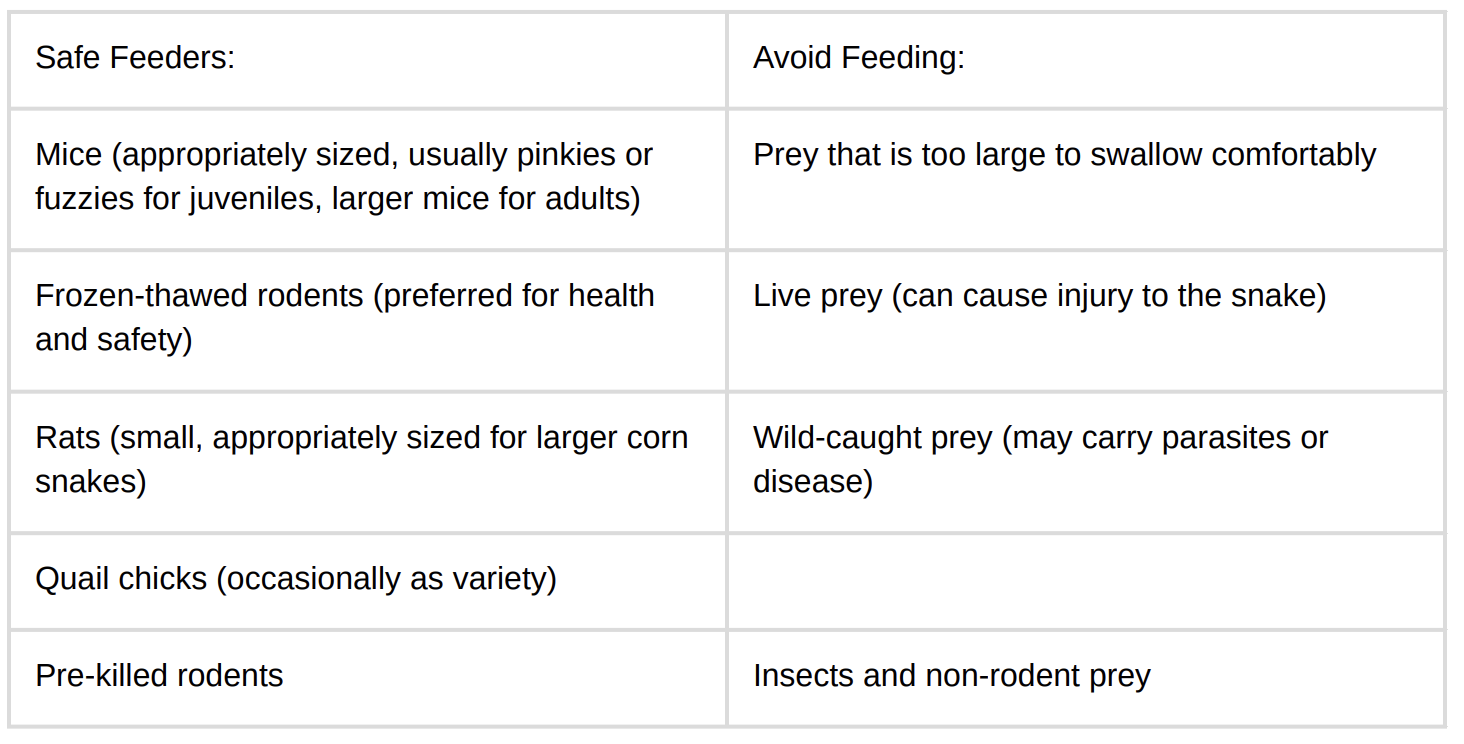Corn Snake Care Sheet
Overview
Corn snakes are one of the most popular reptiles in the pet trade, often recommended to first-time keepers due to their docile nature and relatively straightforward care. However, no animal is truly a “beginner” pet—each species has specific needs that must be met for them to thrive. Native to the southeastern United States, corn snakes are typically calm, easy to handle, and moderately active, especially during the early morning and evening hours. They enjoy exploring and can often be seen burrowing or climbing within a well-furnished enclosure. While they may be easier to care for than some other reptiles, they still require a secure habitat with proper heating, humidity control, hiding spots, and regular feeding of frozen-thawed prey. Corn snakes are long-lived and can reach 15–20 years of age with appropriate care, making them a long-term commitment and a rewarding companion for prepared and responsible keepers.
Species averages:
Habitat Parameters
Housing recommendations
Corn snakes need a secure enclosure with appropriate heat gradients, hides, and enrichment to support their burrowing and exploratory behavior. Glass or PVC enclosures with screen tops or front-opening doors are ideal. The enclosure must be escape-proof—corn snakes are notorious escape artists.
Provide both warm and cool areas using an under-tank heat mat or radiant heat panel on a thermostat. Never use heat rocks. Maintain ambient humidity at 40–60%. Spot clean as needed and perform deep cleans monthly.
Use substrate such as aspen shavings, coconut husk, or paper towels. Avoid cedar or pine, which are toxic. Include at least two hides (one on each temperature gradient), branches for climbing, and a water dish large enough for soaking.
Lighting is not required, but a natural day-night light cycle is recommended. Low-intensity UVB can be used but is not essential.
Feeding
Corn snakes are primarily carnivores and should be fed appropriately sized prey items. Adult corn snakes can be fed once every 7-10 days. Prey should be offered based on the snake's size and age.
Note: Always ensure that the prey size does not exceed the diameter of the snake at its widest part. This helps prevent regurgitation and digestive issues.
Supplementation
Corn snakes do not require dietary supplements if fed whole prey. All necessary nutrients—including calcium, vitamins, and trace minerals—are found in properly sized rodents.
Special considerations
Handling
Corn snakes are usually docile and tolerant of handling. Start with short sessions 2–3 days after feeding or enclosure cleaning to reduce stress. Always support their full body and allow them to move at their own pace. Avoid handling during shedding or illness.
Shedding
A healthy corn snake should shed in one complete piece. Ensure proper humidity and include rough surfaces to aid shedding. If stuck shed occurs (especially around the eyes or tail), offer a humidity box or brief lukewarm soak and consult a vet if it persists.
Hydration
Always provide a clean water dish large enough for soaking. Change water daily, especially after defecation or soaking. Monitor for signs of dehydration (wrinkled skin, retained shed).
Brumation (Optional)
Adult corn snakes may brumate during winter months. This natural dormancy phase should only be done with guidance and full health assessment. Not required for pet snakes unless breeding.
Common Health Concerns in Corn Snakes
Below are some of the most common medical issues in corn snakes. Early recognition is vital for successful treatment.
Respiratory Infection (RI)
Signs: Wheezing, open-mouth breathing, bubbles at nostrils
Causes: Low temps, high humidity, poor ventilation
Mouth Rot (Stomatitis)
Signs: Swollen mouth, pus, gaping, refusal to eat
Causes: Poor hygiene, injury, stress, vitamin deficiency
Shedding Issues (Dysecdysis)
Signs: Retained eye caps, stuck skin, dull appearance
Causes: Low humidity, dehydration
Inclusion Body Disease (rare in corn snakes)
Signs: Regurgitation, neurological symptoms, weight loss
Causes: Viral infection—requires immediate vet attention
Internal Parasites
Signs: Diarrhea, weight loss, regurgitation
Causes: Ingesting infected prey, contaminated environment
These are all concerns we can help with via telemedicine. If you suspect your corn snake may be showing any of the signs above, book an appointment at swiftailvet.com for expert exotic pet care from the comfort of your home.
Disclaimer
At Swiftail Vet, we strive to provide accurate, up-to-date information based on current best practices in exotic pet care. However, husbandry standards can evolve quickly. If you notice any outdated or incorrect information on this care sheet, please let us know by emailing info@swiftailvet.com or using the contact form on our website at swiftailvet.com. Your feedback helps us ensure the highest quality resources for pet owners and their companions.
Written by: Wintergreen Vet Services
March, 18, 2025






